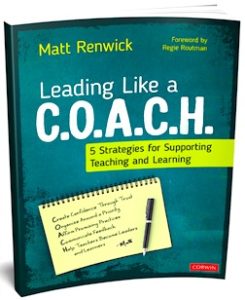20 Questions We Used to Help Fix Our School

By Matt Renwick
In 2016 I remember rifling through our English Language Arts standardized test results and starting to feel frustrated.
● The students who should have scored well performed lower than expected.
● The students who struggled in the past continued to struggle.
● A few students had not completed a section of one of the tests.
Why isn’t our school improving? I wondered. It’s not like we had failed to set goals, or to engage in professional learning, or to try to understand our students’ needs…and then I started to think about what we didn’t know.
For example, could students see how they were becoming better readers and writers, beyond what a test score might imply? Related, did the teachers feel supported in this work? What was their perspective about professional development toward continuous improvement?
I closed the binder of student test reports, unsure of our next steps.
Less Certainty, More Inquiry
Since 2016 I’ve learned that tackling these complex challenges requires letting go of trying to control the outcomes and operating with certainty around how to “fix” them.
What I needed was a better understanding of the challenge itself through professional inquiry. What has helped us move forward has been to break down the complex challenges into smaller questions.
Crafting and pursuing these questions has led to improvement plans that better embrace the reality of the school culture. Our approaches have been more personalized and produced more practical solutions.
The following 20 questions have guided our work; you might find them helpful, too.
How well do teachers trust their leadership and each other?
Trust is the foundation for everything that happens in a school.
In the context of education, trust can be defined as the level of confidence we have in each other and in our efforts to improve outcomes for students. When trust is present, teachers and leaders speak both openly and thoughtfully. There is little fear of negative repercussions from administration or retribution from a close-minded colleague.
The following additional questions can help assess the level of trust in your school.
● Do we regularly engage in authentic and honest dialogue?
● Do we follow through on our responsibilities and commitments?
● Do we demonstrate compassion and caring for one another and our students?
● Do teachers believe they are making a positive impact?
How committed are we to a schoolwide priority?
The priority for a school should describe the larger focus for the organization – for example, “support all students to become successful and engaged readers.”
To be clear, a goal is not a priority. Goals are the expected outcomes that serve as indicators of measured success toward a priority. Following the example above, reading achievement scores can be one goal, but they should not be used in isolation.
Faculty surveys about professional learning, the percentage of students receiving intervention services going up or down, and school library checkout rates can also provide information about this priority.
The following additional questions can help assess the level of commitment to your priority.
● Do we have a diverse set of data to support our goals and objectives?
● Do teachers feel that professional learning is helpful, relevant, and useful?
● Have we reached consensus around our beliefs and practices for effective instruction?
● What evidence do we have that students are responding to our instructional practices?
How supported do teachers feel in the classroom?
If we expect student learning outcomes to improve, leaders are wise to first ensure the conditions are favorable for teachers to succeed.
This can be difficult to accomplish when resources are scarce. There never seems to be enough time, supplies, or opportunities to collaborate with colleagues. Still, what can we do within the constraints of our reality?
The following additional questions can inform leaders to better advocate for what is needed.
● Do we affirm the promising instructional practices teachers are already using?
● Is the faculty empowered to make decisions regarding practices and resources employed in classrooms?
● Do teachers receive regular recognition in their efforts to improve?
● Is the time teachers have to meet regularly and discuss their work protected from outside influences?
Is continuous learning a part of our school culture?
Schools are not unlike other organizations; all systems generally resist change.
This is the nature of systems – they lead to outcomes they are designed to produce. So to foster change within the school culture, it helps to have a consistent approach to professional learning design that pushes back on systems and even improves them.
Opportunities for continuous learning abound: asynchronous online courses, book studies, and professional learning networks can all serve to support these efforts.
And they don’t have to be profound experiences. For example, I showed one-minute coaching videos at the beginning of staff meetings that demonstrated how we can better listen and respond during collaborative conversations with each other.
The following additional questions can guide leaders to assess the level of learning within their school culture.
● Do teachers know how to communicate and receive feedback?
● Are leaders avoiding advice and focusing more on understanding our challenges and responses?
● How do teachers and students know they are on a pathway to success?
● Are all learners – students, teachers, leaders – becoming better at coaching themselves?
Addressed collectively, one question at a time, you can better manage the complexity of leading schools toward success for both students and faculty.
Bonus: To sustain this work, consider reviewing these questions at least annually. Use this Google Doc template, 20 Questions to Better Understand Your School, and honestly respond to each question as an exercise with your leadership team.

Matt’s latest book, with a foreword by Regie Routman, is Leading Like a C.O.A.C.H. 5 Strategies for Supporting Teaching and Learning (Corwin, 2022). You can subscribe to his popular free Read by Example newsletter (and explore the archives) at his website. Follow him on Twitter @ReadByExample.
































